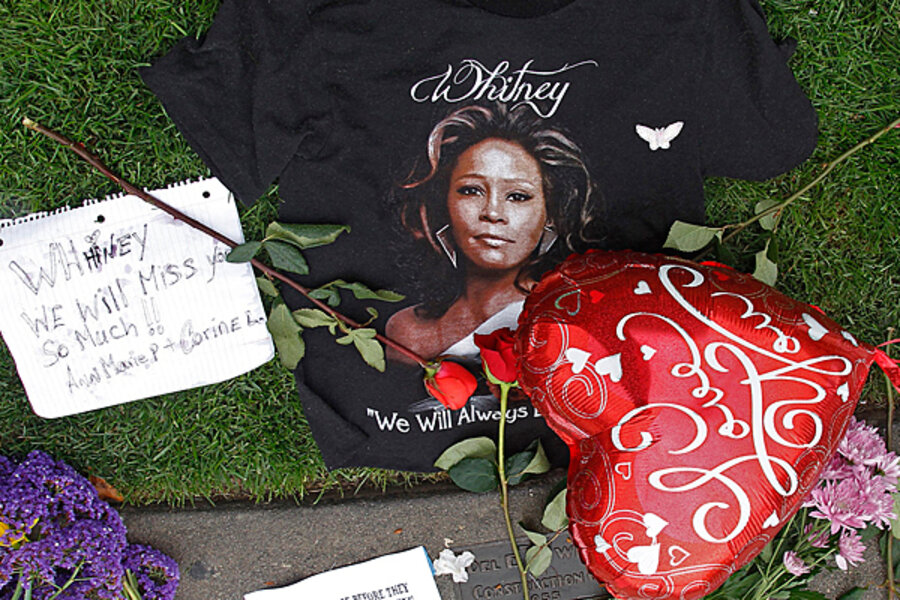Whitney Houston death: a moment of national mourning, shared on Twitter
Loading...
| Los Angeles
The news that singer Whitney Houston had died on Saturday appeared on Twitter before any so-called regular news outlets, such as the Associated Press or Reuters. Within an hour, some 2.5 million tweets about her passing had filled the digisphere, making it the most-tweeted breaking-news event in the medium’s six-year history.
Within 24 hours, the volume had soared upwards of 35 million tweets, making it a “milestone moment,” according to Rishab Ghosh, co-founder and chief scientist at Topsy Labs in San Francisco.
Social media have become so mainstream that they have replaced even TV as providing fodder for water-cooler talk, he says. He points to the exponential growth over just the past year – Twitter feeds alone have doubled every six months – as evidence that they are no longer the tool of a technologically savvy niche.
Rather, he says, Twitter has reached a critical mass of commonplace usage. “It is a truly mass medium,” he adds.
At the same time, however, this crush of tweeting took place in a seven-day period sandwiched by the most-watched event in network television history, Super Bowl XLVI, with 111.3 million viewers a week ago, and the Grammys on Sunday, with its second-highest ratings ever, 39 million viewers. That was the highest since 1984, which was more than two decades before Twitter’s creation.
“What this means,” says Robert Thompson, founder of the Bleier Center for Television and Popular Culture at Syracuse University in New York, “is that just because social media is expanding does not at all mean that legacy media such as broadcast TV needs to die.”
This is not, he says, a modern version of the kerosene industry fading away when the electric light bulb appeared. Rather, he says, these tools coexist and feed one another. Most people use Twitter while they are doing something else, he points out. “They sit in front of a show like ‘The Bachelor’ and tweet their outrage over who got the rose, or they are streaming the football game and tweet their upset over a fumble,” he says.
While individual networks and shows may reflect declining ratings, he notes, aggregate TV viewing in the past year has actually gone up. “This includes all the various outlets from cable to satellite,” he says.
But if television viewing has not declined in the wake of social media’s advance, the mainstreaming of new tools has brought new challenges. The danger in social media is the rush to be first on a news story, says former broadcast newsman John Goodman via e-mail.
He points to the recent push to report the death of Joe Paterno. “Everyone was in such a crush to be first with breaking news that they declared Paterno dead virally 12 hours before he died.” A lot of media outlets, some of them credible, he notes, “got the story wrong.” He continues, “Those who cover news – legitimate news organizations to bloggers and those who live on Twitter – now face a dilemma...: be first on a breaking-news story and risk being wrong, or be first and right.”
The thicket of legal and ethical issues will continue to grow as social media mature, points out Florida attorney Larry Walters, who specializes in First Amendment law. “We are all sharing information about ourselves digitally and freely at an exponential rate,” he says, but it is not at all clear who has the right to use or sell it.
“The law itself is in its infancy on this topic,” he says, noting that when it comes to the government data-mining for keywords as a tool for law-enforcement or security purposes, social media are taking society into uncharted territory.
Indeed, it’s not at all clear where new tools will take us, says London-based new-media specialist Alan Stevens. At the moment, he says, users are simply thrilled to have an outlet for their opinions. However, he notes, just as many bloggers have begun to realize that posting a blog does not necessarily mean there will be readers.
“There will inevitably be a falling off as some people realize that having a voice doesn’t mean anyone is actually listening,” Mr. Stevens says.
This is a typical, first flush of usage for a new technology, says Charles Palmer, executive director of the Center for Advanced Entertainment & Learning Technologies at Harrisburg University of Science and Technology in Pennsylvania. “As people integrate it into their daily usage, they will probably find there are times they use it a lot,” he says, “and there will be times when they don’t use it at all.”
He adds, “Nobody can keep up with the pace of a constant Twitter stream.”





